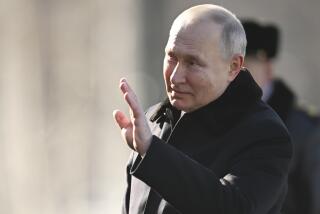Pentagon Aide Talks of Shift on ABM Treaty
- Share via
WASHINGTON — The Reagan Administration’s decision to adhere to a strict interpretation of the Anti-Ballistic Missile Treaty’s limits may be abandoned in the future to permit wider research, development and testing under the “Star Wars” program, a senior Pentagon official said Wednesday.
Richard N. Perle, assistant secretary of defense for international security policy, told a group of reporters at a breakfast meeting that any new work on “Star Wars” technology will “be weighed with the knowledge that we have the full legal right to act,” based on a new interpretation of the treaty.
The 1972 ABM treaty between the United States and the Soviet Union in 1972 places sharp restrictions on the development and installation of land-based systems that could shoot down or destroy an opponent’s ballistic missiles.
However, the new interpretation of the pact surfaced last week when national security adviser Robert C. McFarlane said on a television program that research, development and testing of ABM systems “involving new physical concepts . . . are approved and authorized by the treaty. Only deployment is foreclosed.”
The remarks are part of a continuing debate within the Administration over whether the treaty limits development and testing of space-based missile defense systems unforeseen when the pact was prepared, such as those under the Strategic Defense Initiative, or “Star Wars,” research program.
Secretary of State George P. Shultz, seeking Monday to resolve questions about the treaty’s restrictions, said that development and testing under the “Star Wars” program would be limited to comply with the narrow interpretation of the treaty that has been followed since the treaty was ratified, even though the Administration disagrees with this reading.
But Perle said that, “with respect to the . . . future elements of the program, it remains to be seen which interpretation would apply.”
More to Read
Sign up for Essential California
The most important California stories and recommendations in your inbox every morning.
You may occasionally receive promotional content from the Los Angeles Times.













